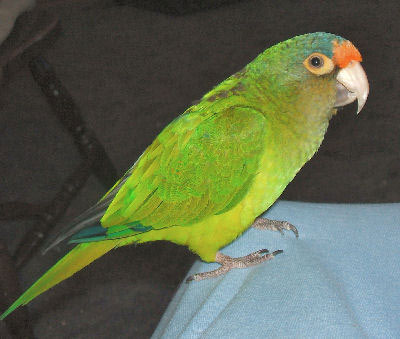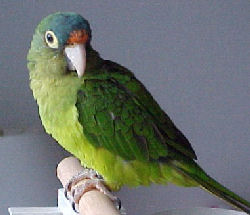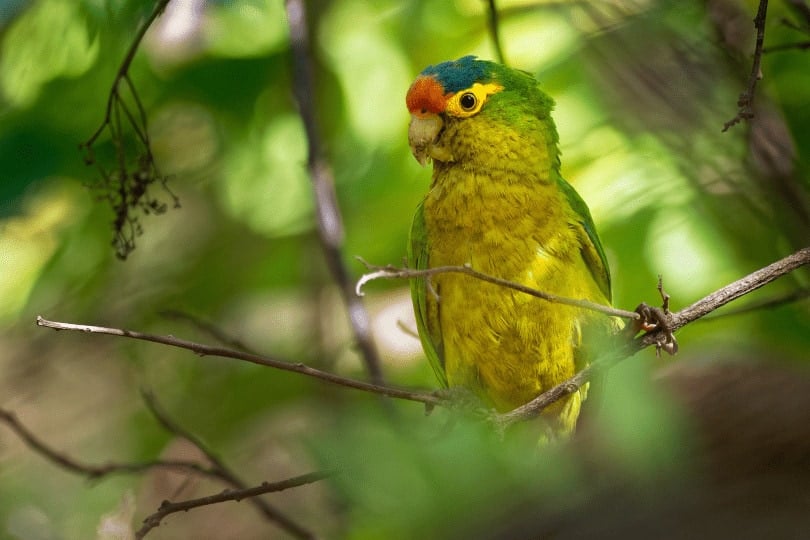
A happy little bird, the Half-Moon Conure has a wonderful temperament and is very friendly. They are very popular and fun pets!
The Half-Moon Conure is a lively, alert, spontaneous little bird. They will bob their head and even dilate their eyes when they are happy to see you, are showing off for you, or are just plain excited!
Though they can be noisy the Half-Moon Conure has a lower volume to their call. They are considered to be one of the quieter birds in the Aratinga species. They enjoy mimicking a variety of sounds and some, like “Lucky”, can even be great talkers.
“His name is Lucky and he is two years old. They (Half-Moon Conures) are some of the best talkers as far as the conures go!” …Crystal McCraine”
For more information about the care of Conures see:
Guide to a Happy, Healthy Conure
- Kingdom: Animalia
- Phylum: Chordata
- Class: Aves
- Order: Psittaciformes
- Family: Psittacidae
- Genus: Aratinga
- Species: canicularis
Scientific Name:
Orange-fronted Conure Subspecies (3):
- Petz’ Conure
Aratinga canicularis canicularis - Half-Moon Conure
Aratinga canicularis eburnirostrum - Aratinga canicularis clarae
Distribution:
Though Half-Moon Conure is native to southwestern Mexico, the other two species of Orange-fronted Conure range in western Central America from Sinaloa, Mexico, south to western Costa Rico.
Description:
The Half-Moon Conure has a narrow frontal orange band that extends down to the lores and a forecrown that is blue. They look very much like the other Orange-fronted Conures though a tad bit larger than the Petz’ Conure, and they have a brown spot on each side of the base of the lower mandible. They are also similar in appearance to the Peach-fronted Conure but have a macaw-like beak that is horn colored.
They have a generally green plumage with a greenish-yellow underside and yellow to olive-yellow under the wings and tail. The outer parts of the wings are blue. Like the macaws they have a naked eye ring. Their eye ring is a dull orange-yellow and the iris is pale yellow. Juveniles have a brown iris and the orange frontal band is narrower. Females also have a narrower frontal band.
Like most conures of this size, they have an average life span of about 30 years and possible longer.
Size – Weight:
These birds get up to 9.5″ (24 cm) and 2.6 ozs. (74 g). Generally a little larger than the Petz’ Conure which is about 2.5 ozs. (71 g).
Care and feeding:
Half-Moon Conures are not as destructive as many of the others conures, and can easily be housed is a lighter weight cage such as a cockatiel cage. A roomy cage is appreciated unless the bird is to be let out for periods of exercise and play.
In the wild many of the Orange-fronted Conures eat figs, seeds, nuts, berries, and blossoms, but the Half-Moon Conure has been observed to feed mostly on fruits, so much so that their feathers are often found to be sticky. In captivity these birds will eat an avian pelleted diet as well as a wide variety of fruits. They are not as quick to bathe as most conures. Offer them a bath, or if they are not interested in that give them a misting of warm water with a spray bottle or in the shower or sink about every other week.
See About Conures: Housing and About Conures: Care and Feeding for more information.
 Lucky Photo Courtesy: Crystal McCraine Lucky Photo Courtesy: Crystal McCraine“Half-Moon Conures are some of the best talkers. Lucky is two years old… Crystal McCraine” |
Social Behaviors:
All Orange-fronted Conures are social birds and live in fairly large flocks in the wild (up to about 80 birds) for a good part of the year. During mating season however, they pair up and live alone or with a few other pairs. They love to play and will preen each other during resting periods.
Activities:
They love to climb and play. Provide lots of toys. Many birds can spend most of their time on a play pen or parrot perch.
Breeding/Reproduction:
In their natural environment these birds nest in termite mounds, digging out a long upward climbing entry that then makes a sharp turn into a cavity dug out in the middle of the mound. They have been observed to use the natural hollow of a tree when termite mounds are not available, but this is the exception rather than the rule. Captive breeding is a bit more difficult than with other conures because of their preferred natural nesting place, but they are being successfully bred.
Though these birds will need to be either DNA or surgically sexed for a certain determination, the females will generally have a narrower frontal band.
The hen lays three to five eggs, one every other day, which are then incubated for about 30 days. The female broods the eggs and does the Initial feeding when the hatchlings are first born. The male then gradually takes over the feeding. The young fledge (leave the nest) after about six weeks. A nest box size should be 13″ x 10″ x 10″ with an entrance hole about 3.25″ in diameter.
Potential Problems:
As with many Aratinga species, Half-Moon Conures can be noisy but are generally considered a quieter conure. Not nearly as noisy as most of the Aratinga species are.
See About Conures: Potential Problems for information on illnesses.
Availability:
The Half-Moon Conure is very popular and available from time to time. Your best bet is to find one at a pet store or a reputable breeder.
Featured Image Credit: Martin Pelanek, Shutterstock
